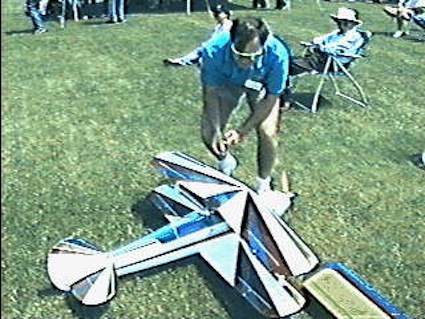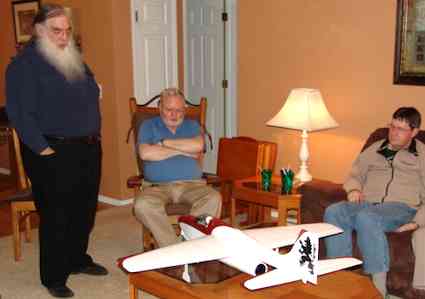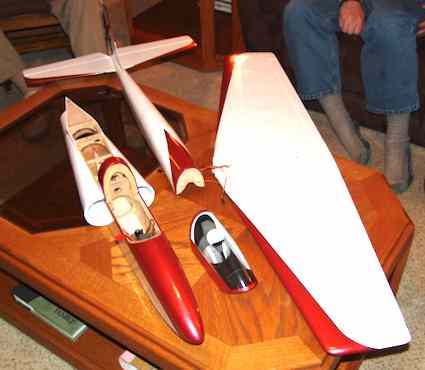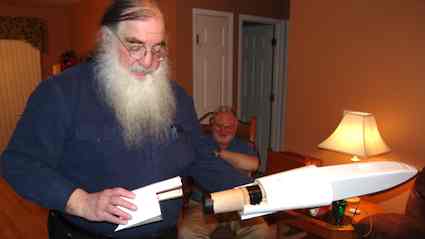 |
Flying High With Electric Power!
The Ampeer ON-LINE!
Fly the Future - Fly Electric! |
Site Table of Contents
| President: | Vice-President: | Secretary/Treasurer: |
| Ken Myers | Richard Utkan | Rick Sawicki |
| 1911 Bradshaw Ct. | 240 Cabinet | 5089 Ledgewood Ct. W. |
| Commerce Twp., MI 48390 | Milford, MI 48381 | Commerce Twp., MI 48382 |
| (248) 669-8124 | (248) 685-1705 | 248.685.7056 |
 | ||
| Board of Directors: | Board of Directors: | Ampeer Editor |
| David Stacer | Arthur Deane | Ken Myers |
| 16575 Brookland Blvd. | 21690 Bedford Dr. | 1911 Bradshaw Ct. |
| Northville, MI 48167 | Northville, MI 48167 | Commerce Twp., MI 48390 |
| 248.924.2324 | 248.348.2058 | 248.669.8124 |
| Mailed Ampeer printed subscriptions are no longer available.
The Ampeer is FREE on-line in Acrobat .pdf format and HTML with active links! | ||
| The Next Meeting:
Date: Sat., Oct. 5 Time: 10:00 a.m.
Monthly Flying Meeting Place: Midwest RC Society 7 Mi. Rd. field | ||
| What's In This Issue? | ||||
| Follow-up on a Hacker A50-12S, Jim Young notes the performance increase in his Super Skybolt with this motor. | The April EFO Meeting Roger Wilfong's Eraze, Stingray, Fast and Furious and a glue tip, Hank Wildman's scratch-built retracts for his airliner, Charlie Dochenetz LT-25, Keith Shaw's Akro-Jet, Bill Brown discusses the motors for his Wright Model 'B' scratch-build, Arthur Deane shared info on new, safer Li-Po batteries, and Ken Myers shared an Antonov An-2 Video and information. | |||
| TigerKitten Landing Gear Suggestion Ron Fikes suggests an alternate landing gear for the TigerKitten to reduce bouncing on landing. | Brushless Motor Wattage Rating Question Don Patterson asks a question about wattage ratings and Ken replies. | |||
| More on Selecting a Li-Po Battery for a Given Motor, Roger Wilfong explains another method to use to select a Li-Po for a given motor. | Heads-up On the O.S. Motor OMA-50xx-xxx Motors, Ken shares info on the reverse thread socket head cap screw used to secure the shaft in these motors. | |||
From Jim Young via email
Hi Ken, "Just a follow up on the Hacker A50-12S we tested at the March EFO meeting. I've got it mounted in the Super Skybolt and I've had it out once with a 13x6.5 Xoar prop on it. I had not done any measurements before flying it, but the new motor and prop brought new life to this 17(?) year old plane. I was still running it on an old TP 6S 3200 pack that is puffed quite a bit. Performance was much better than the AF40G with the 13x8 APC. I was flying most of the flight at a much lower throttle setting than normal. There was a strange noise around 60% throttle, so I decided to do some bench tests and try a few other props. Running up the motor in my shop, the noise I heard flying was the hacked together motor mount vibrating. At first I thought the prop was out of balance, but after double checking and trying a new prop it turned out to be a resonance with the motor mount. On one run up the motor mount broke, so repairs were in order. The mount is basically two 1/8" plywood plates extending about 3" from a fuselage former with a 1/8" firewall glued between them. The AF40G was supported in a 1/64" plywood tube and had a rear former supporting the tube between the plates. The Hacker is front mounted to the firewall and there was no cross bracing between the plates. The mount was just too flimsy for all this power. The mount now is fiber glassed around the front and cross bracing was added. With everything back in place the vibration is gone at all speeds. I've put in a new Nanotech 6S 3500 pack and run the 13x6.5 Xoar and the previous 13x8 APCE. The new pack makes a big difference and yields 1v to 1.5v more at full throttle than the old TP pack. The 13x6.5 draws about 34A and the 13x8 draws about 49A both around 22V on the pack. The 13x8 is definitely out, since I'm using a CC 50A ICE Lite ESC. The 13x6.5 is taking about 750 watts in, which is plenty of power for this 7 pound biplane. I'm looking forward to enjoying this bipe for another 17 years! Thanks,
My Response: Thanks Jim, Glad it is all working out well for you. We had a lot of fun and learned a lot about this motor at the EFO meeting, and now with a flight test report, it seems that our static evaluations proved useful and accurate. I had a similar incident with a front mounted outrunner in my Dymond Modelsport Ltd. Flite 40 low-wing sport plane in 2007. The motor was/is an HXT 42-60 made by XYH. Generically it is an HXT/Turnigy/EMP 4260-560Kv, 270g outrunner. The vibration caused the motor to disassemble in the air, removing the front end/cowl of the plane. 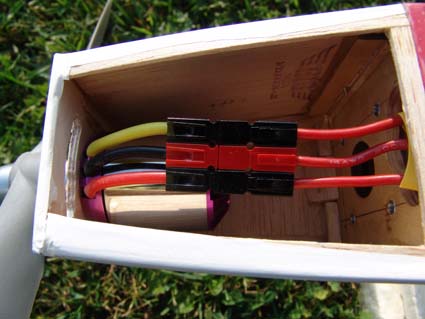
Original mount - not shown is the 1/4" triangle stock epoxied between the fuselage sides and motor mount The first photo shows how it was originally mounted. 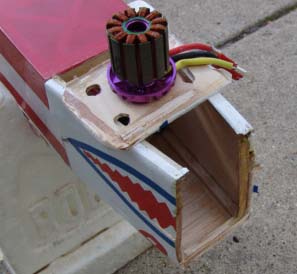
After Landing - 1/4" balsa triangle stock can be seen The second photo shows what was left when I landed the plane. 
New Mounting System The April 11 EFO meeting was another good one! 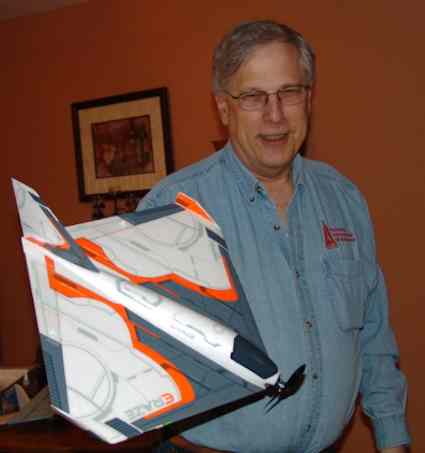
Eraze Roger Wilfong started the evening of sharing with three new planes. His first one was the new Flyzone Eraze. 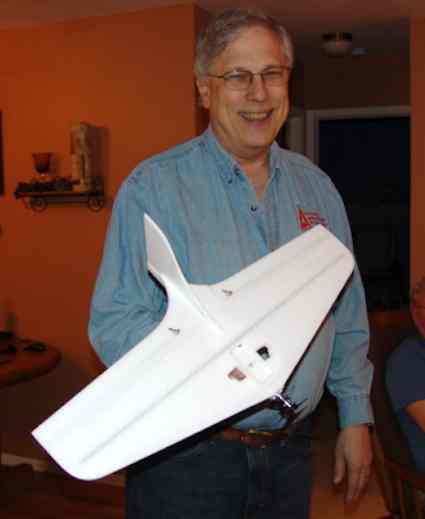
Stingray He also showed us how he used Beacon Foam-Tac glue to make the hinges for the Stingray and Fast and Furious. 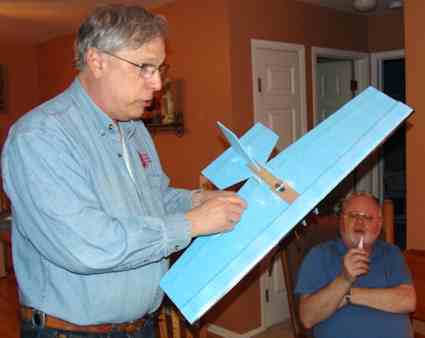
Fast and Furious This type of hinging is demonstrated in a video. 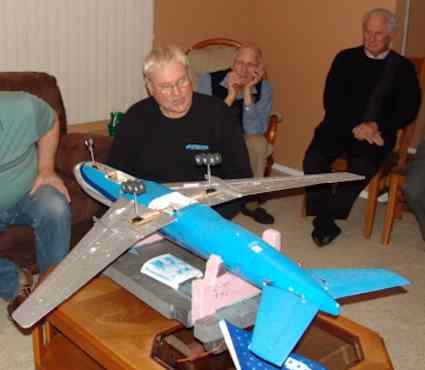
Hank with his airliner Hank Wildman brought his airliner to show off the progress on his scratch-built retractable landing gear and multi-wheel systems. Hank does all the design and machining himself. Good work, Hank! After Hank had shown us his retract progress on his airliner, Keith Shaw noted a glue that is even better than silicone for attaching things like landing gear doors to legs. It is Locktite Stik'n Seal. It sets in about 5 minutes and can be peeled off for a little while after that. It cures in about 24 hours and the adhesion is excellent while still being somewhat flexible. 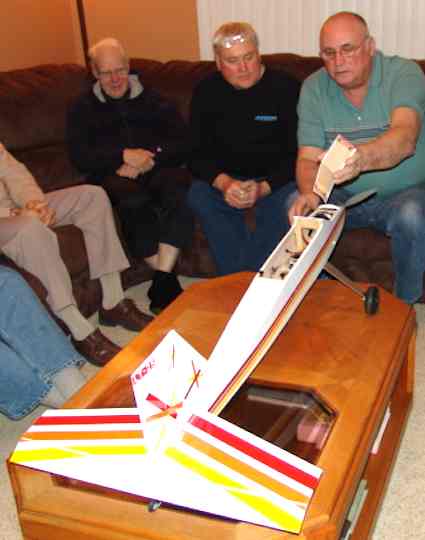 Charlie Dochenetz brought his Sig LT-25. Charlie built it from the kit and included several unique modifications to make the power system more accessible. It is beautifully finished. Its power system includes an O.S. OMA-3825-750 outrunner, Castle Creations Ice 50 and a 4S "A123" 2300mAh pack. 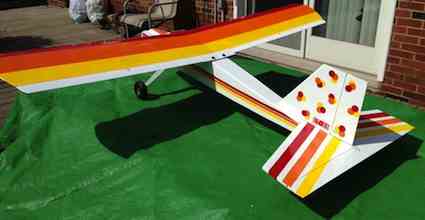
Keith Shaw brought his Akro-Jet, fresh from its first place finish award for best film finish at the Toledo RC Expo. It is a sport pattern electric ducted fan design that Keith is going to use to investigate precision jet aerobatics. The design was inspired by the Polish "Iskra", a trainer jet and well-known aerobatic performer. The Details:
Keith noted that the 12-blade fan unit is exceptionally quiet when compared to other EDF units. It sounds more like a turbine and there is no screaming sound. It has a lot of 'special' touches including great gear door mechanisms.
It disassembles extremely easily for both transportation and easy access to the components. As usual for Keith, the engineering that went into this design is remarkable and he did all in six weeks! Bill Brown brought along a new motor, one of two, that he picked up at the Toledo show for his Wright Model "B". He was looking at possibly using a Feigao 1208436L brushless instead of brushed motors. Now he's settled on the Hacker E10-36L brushless motors. He'll be trying them with different gear ratios. He also needs to figure out how to get a third wire to each motor from the ESCs, since he already had it wired for a brushed motor. Arthur Deane shared some interesting news concerning Li-Po batteries. He read in the May 2013 issue of Motor Trend about a nano-technological cure for Li-Po fires that is under development at the University of Illinois in Urbana-Champaign. Aerospace engineering professor Scott White has proposed smearing a thin coating of nanospheres on either the anode or the separator layer to serve as a sub-microscopic fire brigade. The process is still in the research phase, so don't look for the commercial application soon. 
Ken Myers near prop of Antonov An-2 at the Yankee Air Museum Ken Myers shared a short video of a full-scale Antonov An-2 Colt flying. Ken has been interested in the An-2 for several years now and pre-purchased the ARF from Maxford USA while at the Toledo Show. (Ken reviewed the model in the September 2013 Ampeer). TigerKitten Landing Gear Suggestion
Ken, You gave me advice on Tiger Kitten balance, love flying my Kitten - but - the landing gear that came on it was 1/8" thick. It worked OK but it was hard to land without a bounce. I ordered another gear, Sig RPBA 249. It fits the Sig Kadet, Kavailer, and MidStar 40. This gear is the same dimensions as my old one (even the bolt pattern matches). It is about 1.5" wider tread (good) BUT only 3/23" thick, which is more fitting to the 2.5 pound weight, and does it land better! It saved me from making up a wire gear. Thanks again,
From Don Patterson Hi Ken, I have asked people from Hobby Lobby for several years about publishing wattage ratings for their motors like most other manufacturers do. They have thus far resisted doing so. I can relate to wattage much better than the data that Hobby Lobby publishes. Please share your thoughts on comparing AXI ratings to Rimfire, Hacker, etc. Hobby Lobby data for AXI 4130/16. Thanks and take care,
From an email to Hobby Lobby by Don: I would like to calculate a maximum practical wattage that AXI motors would be able to accept without damage from the data Hobby Lobby publishes. This information is readily available for Rimfire and E-Flite motors but for some reason not for AXI motors. When I am selecting propellors for my system I want to know what wattage I cannot exceed. I do own an electric flight wattmeter.
My response: Maximum watts in (Win) is not a good way to decide if the motor is appropriate or not. Some suppliers note that number and some do not. It is the amp draw that is most important. What amp draw; constant, maximum/surge or unspecified? Presented below is some typical data supplied on various Web sites. After the data are some calculations that should make sense after looking at all of the data. Generic motor data is the diameter in mm followed by the 'can' length in mm, a dash then the Kv followed by a comma and the weight in grams. This is a reasonable way to 'equate' similar motors. AXI 4130/16 is generic AXI 5066-385, 409g data. Win none given
Great Planes Rimfire 1.20 50-65-450 is generic Rimfire 5062-450, 400g data Max. Constant Watts: 1480W
Note: This motor is not in the same group as the rest of the motors because its Kv is about 50 RPM or more higher than the rest of the group. It is only included because it is the only offering that Rimfire provides in this weight group. Cobra C-4130-16 is generic Cobra 5062-390, 396g data Max Continuous Power on 5S Li-Po 1020 Watts
E-flite Power 60 is generic E-Flite 5062-400, 380g data Ideal for models requiring up to 1700 watts of power
Scorpion S-4035-380 is generic Scorpion 4963-380, 430g data Max Continuous Power 2600 Watts
NTM Prop Drive 50-60 Series 380KV is generic NTM 5060-380Kv, 468g data Max Power: 2665W @ 30v (8S)
O.S. .50 Brushless Outrunner OMA-5025-375 is generic O.S. 5058-375Kv, 405g data Rated Power: 1550W
Note: Once again O.S. Motor has 'messed up' their data on the specifications page. It appears that Tower Hobbies tried to 'fix' the data that they posted on their Web page for the motor, but I cannot figure out how Tower Hobbies got some of their numbers. When the information about the NTM and Rimfire are disregarded because they do not 'fit' in the group, then the basic motor is a generic 5060-400Kv, 400g outrunner motor. Some formulas that I use now are: Maximum Continuous Amps - wt. in g ^ 0.6666667
Note: This is the least useful to me as the acceptable amps change with the winds on the ‘same’ motor. With a ‘trusted’ source, use the recommended maximum continuous amp draw. Maximum Continuous Win - wt. in g ^ 0.25 * wt. in g
Maximum voltage 1790Win / 54.3 amps = 33v (~9S) ESC size - 54.3 amps * 1.25 (the inverse of 80%) = 67.9 amp At the maximum predicted continuous 1790Win, a 65 amp or greater ESC that is capable of supporting a voltage of 9S or greater should be fine. For most ESC brands a ‘high voltage’ ESC would be required to handle a 9S Li-Po or greater. 9S 33.3V * 54.3A = 1808Win
8S 29.6V * 54.3A = 1607Win
7S 25.9V * 54.3A = 1406Win
6S 22.2V * 54.3A = 1205Win
5S 18.5V * 54.3A = 1005Win
4S 14.8V * 54.3A = 804Win A 4S is not very good choice for this motor as it is consuming less than half the continuous predicted power. Compare the above calculated data to the Cobra recommendations. I am NOT suggesting that my formulas are the best solution to the varied information provided by suppliers. It is conservative, to be sure, but it is working for me right now. The most 'trusted' information that I've come across is that provided by Lucien Miller of Innov8tive Designs for his Cobra line of motors. Here is his real world battery and prop testing data for the Cobra C-4130-16. Look at the charts for 5S, 6S and 8S Li-Po cells and notice which props can be used with about the predicted 54 amp draw. More on Selecting a Li-Po Battery for a Given Motor From Roger Wilfong, EFO member The article on power system selection, "Selecting a LiPo Battery for a Given Motor" in the May 2012 Ampeer got me thinking. I've frequently used Orme's Law as a part of selecting a power system. It was developed by Matthew Orme, sales manager for Aveox, to help recommend power systems to for his customers' planes. I don't see Orme's Law referenced much anymore, although it does have a Wikipedia entry. While the original statement of the Law is a bit dated, it is still useful as a component in selecting a power system. As you note in the article, the motor is really just an energy conversion device that converts the electro-chemical energy stored in the battery to mechanical energy. The battery really needs to be matched to the plane/mission and the motor selected to efficiently convert the battery energy to prop power. Orme's Law is a tool that can be used to size a battery for a plane. Simply put, Orme's Law is a rule of thumb that relates wing area to total battery energy (Watt-Hours or voltage times capacity). Matt developed his rule of thumb back in the pre-LiPo days when 1700mAh - 2000mAh NiCd cells were common, so it is stated in terms of number of NiCd cells per wing area. The Law produces a recommendation that, depending on individual flying style, provides 6 to 8 minutes of flight time. As with all rules of thumb, Matt made some basic assumptions. - The plane is a low-wing sport model that flies on the wing. Less energy is needed for a high wing trainer.
Using those assumptions Orme's Law can be stated as: 1) Number of NiCd Cells (for a sport plane KM) = Wing Area in sq.in. / 35 sq.in. That is, use one 1700mAh - 2000mAh NiCd cell for every 35 square inches of wing area for (sport planes KM). For a high wing trainer, the number in the denominator is 50 sq.in. Unfortunately, battery technology has moved on and few use NiCd (or NiMH) cells any more, but Orme's Law is still valid. It just needs to be updated and restated to be battery technology neutral. Just how much energy is in a 2000mAh NiCd cell? Energy is just (Power * Time). Since electrical power is just voltage times current, electrical energy in basic units is just (Voltage * Current * Time). A cell's capacity is (Current * Time), so we can calculate a cell's energy by multiplying capacity times the terminal voltage. The rule of thumb with NiCds was that under load a cell's terminal voltage was 1.0 volt to 1.1 volts. Using the conservative number of 1.0 volt (per cell KM), we can calculate the energy (Watt Hour - W-H) in a cell using the following formula: 2) Energy/NiCd Cell = Capacity (in Ah KM) * Voltage = 2000mAh (2Ah KM) * 1.0 V = 2 W-H If we multiply the number of cells from Orme's Law (formula 1 above) by the energy per NiCd cell (formula 2 above) we can convert the Law's formula into a prediction of Energy instead of the number of a specific capacity NiCd cells. Orme's Law to determine the energy needed to fly a low wing pattern model becomes; 3) Energy = (2 W-H/Cell) / Number of NiCd Cells
Since this is just a rule of thumb estimate, we can simplify the math a little by multiplying the numerator and denominator by three and rounding the resulting 105 in the denominator to 100 (it actually inflates the prediction by about 5%). For a low wing aerobatic sport plane, the restated Orme's Law is: 6) Energy = Area * 6 W-H / 100 sq.in. If you're dealing with a high wing trainer, you can substitute 4 W-H for the 6 W-H in formula 6. We now have the energy needed, but we'll need to convert that into a number of cells. For that we'll need to know the energy in the different kinds of cells. How does this work with current technology batteries? 2200mAh LiPo packs seem for be a common "standard" size. The nominal voltage of a LiPo cell is 3.7V. We can use the same formula for a LiPo cell as we used for the NiCd cell above. In this case, we get Energy/LiPo Cell = 2200mAh * 3.7 V = 8.14 W-H. Dividing the energy from formula 6 by the energy per 2200mAh LiPo cell we get: 7) Number of LiPo cells = Energy / Energy Per Cell
This works for a 2200mAh LiPo cell. Obviously the 8.14 W-H figure will be higher for a larger capacity LiPo pack and lower for a lower capacity one. The numbers will also be different for LiFe or whatever new technology emerged tomorrow. One other thing this highlights is what we've always known; you can create and use the energy to fly a plane by either having a high voltage and low capacity or low voltage and high capacity. Within the limits of the battery's internal resistance, it doesn't matter which path you choose. The choice between these options needs to be based on other factors, such as prop diameter, motor Kv, motor efficiency, battery "C" rating, etc. An example of applying Orme's Law is my 4 Star 380 (an 80% copy of the Sig 4 Star 40, similar to, but predating, the Sig 4 Star 20). It has 380 sq.in. of area. I wanted to fly it using 2300mAh A123 cells. It's a sport pattern plane so I used formula 6 and found the energy needed was: Energy = 380 * 6 W-H / 100 sq-in = 22.8 W-H. The A123 cells have a nominal voltage of 3.3 volts per cell. Multiplying the voltage times the capacity, 2300mAh, gives 7.59 W-H of energy per cell. Using formula 7, we can figure the number of A123 cells needed: Number of 2300mAh A123 Cells = 22.8 W-H / 7.59 W-H per Cell = 3 Cells I originally powered the 4 Star 380 with a geared Astro 035 Cobalt motor on three A123 cells (Why a brushed motor? Because I had it and it had the right Kv to swing the prop that would fit on the 4 Star 380 running on a 3S A123 pack). It flew well on this power system giving 6-7 minute flights the way I fly. Orme's Law worked for selecting the battery in this case. As a side note, I subsequently blew-up the Astro 035 while experimenting with different prop/battery combinations (4S A123 cells produces an RPM that is too high for the 035's commutator - which threw a couple of segments, destroying the motor). There is now a brushless out-runner in the 4 Star 380, and its lower Kv demanded a higher voltage to swing the proper size prop. The 4 Star 380 now uses a 4S A123 pack. Because the brushless motor is a little lighter than the Astro 035 and gear box, the combination of the added cell and the lighter motor only increased the flying weight marginally. Not surprisingly my typical flights on this power system only use about 1500mAh -1600mAh from the 4S pack - with the 3S pack on the 035 I was using about 2000 mAh. This further confirms Orme’s Law in that I'm still using about the same energy (less capacity at a higher voltage) to fly the same plane in the same way. (22.8 W-H / 1700mAh or 1.7Ah * 3.3V = 4.06 cells KM) Roger Heads-up On the O.S. Motor OMA-50xx-xxx Motors
Because of an 'oops' I had with my Maxford USA Antonov An-2, I had to replace the shaft on my OMA-5010-810 outrunner. The OMA-5010-810, OMA-5020-490 and OMA-5025-375 have a rather unique method for retaining the prop shaft. The shaft itself is REVERSE threaded for a REVERSE thread 4x10mm socket head cap screw. I learned this the hard way when I broke the socket head cap screw while trying to disassemble my motor to replace the shaft. Unfortunately, Tower Hobbies did not have the screw in stock when I needed it. They had also did NOT note this 'special' screw when I received the new shaft. After some vexation via emails to Hobby Services, the information is now on the Tower Hobbies' Web site for the shafts and screw. Tower Hobbies calls the screw an "O.S. Main Shaft Stopper SET OMA-50". There is now a note on the shaft page that reads, "The threads for the Main Shaft Stopper, OSMG9690, are reversed.
On a very positive note, I got to see the excellent work on the inside of these very nicely produced motors. |
To Reach Ken Myers, you can land mail to the address at the top of the page. My E-mail address is: KMyersEFO@theampeer.org
